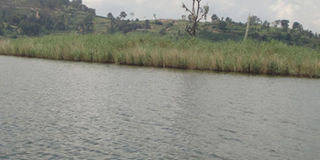Is nature punishing Lake Bunyonyi Punishment Island?

Punishment Island locally known as Akampene Island in Lake Bunyonyi is being submerged by water.
Photos by ROBERT MUHEREZA
The Punishment Island on Lake Bunyonyi locally known as Akampene that used to be a dumping place for girls that got pregnant before marriage in the Kigezi sub-region could soon be totally submerged in water. Only two dry trees and small grassland are what remains of the island today.
The island is being eaten away by nature although a section of locals in Kabale District believe the spirits of the girls that died there could be the reason for its shrinking.
Keneth Tumusime, a community leader around Lake Bunyonyi, says Akampene is one of the prominent tourist sites on Lake Bunyonyi because of its history.
“Elders have been telling us the island used be relatively big measuring about three-acres in size but now it is approximately a plot of about 100ft. I am worried that in the next few years, the island might be no more,” he says, dispelling the myth that spirits are involved.
Tumusime urges government and conservationists to pile more stones, soil and plant beautiful flowers and trees to conserve the island.
However, Diaz Drakes, an investor on Lake Bunyonyi and a social mobiliser at Sharp Island, reveals that it’s not only Akampene being eaten away, but other historical islands such as the Sharp.
This is where a missionary doctor Len Sharp lived in the early 1920’s as he treated patients of leprosy that were always gathered at the adjacent Bwaama Island. The historical Upside Down Island is also being affected.
“Because of the strong water waves, lake water always hit hard the main land and the island and on return it washes away huge soil particles and stones. The fact remains that if nature dictates, man cannot hesitate.
Even if more soil and stones are heaped on the shrinking islands, they, too, will still be washed away by the strong waves of the lake. We shall always pray to God who created these islands to prevail so that the future generation can also see and appreciate the original beauty of Lake Bunyonyi,” Drakes says.
He adds that it is true that during the rainy season, water levels on Lake Bunyonyi increase and reduce during the dry season and it is then that one can see the gullies on both the main land and the island evidence that the waves are eating away the soils and stones around it.
Diocese of Kigezi owns four islands on Lake Bunyonyi and the bishop, Rt Rev George Bagmuhunda, recently appealed to investors in the tourism industry on Lake Bunyonyi to exercise maximum waste management policies to avoid polluting and destroying the beauty of the area.
While speaking at the launch of Sharp Island Gorilla Lodge on Lake Bunyonyi, Austrian investors Walter Inmann and Robert Judtmann, insisted that whereas nature is at play, residents and investors around the lake must play their role of conserving the lake for future generations to enjoy and appreciate.
“Lake Bunyonyi with its 29 Islands and also being the second deepest lake in African adds a lot of beauty to Kigezi sub-region. We must use and preserve this God-given resource sustainably for the future generation to appreciate besides the current needs for money and other economic desires.
People around this Lake must also practice good farming methods to avoid draining the neighbouring wetlands, a trend that might lead to the silting of this beautiful lake,” Bishop Bagamuhunda said.




